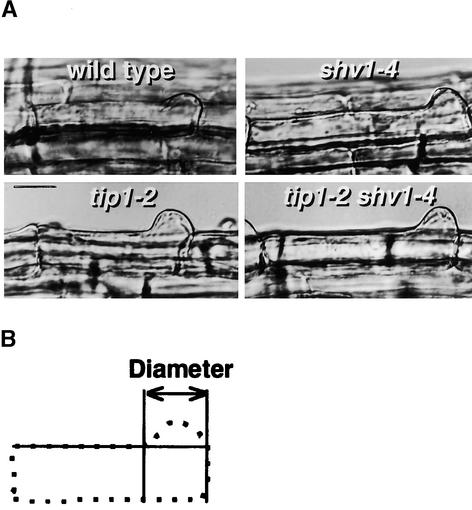Figure 5.
tip1-2 Affects the Diameter of the Swelling Formed during Root Hair Initiation.
(A) Young root hairs of wild-type, shv1-4, tip1-2, and tip1-2 shv1-4 plants. Most root hairs on shv1-4 (4%, sd ± 2%) and tip1-2 shv1-4 (9%, sd ± 3) plants did not progress beyond the stage shown (see Tables 1 and 4). For this character, shv1-4 tip1-2 plants had the shv1-4 phenotype (Table 1).  .
.
(B) Measurement of the diameters of young root hairs similar to those shown in (A). The shape of a root hair cell is shown with a dotted line. A horizontal line indicates the shape of the cell that had no hair formed, identifying the limits of the swelling that had formed at the beginning of hair formation. Student's t tests showed that the diameters of wild-type (21.55 μm,  ) and shv1-4 (21.82 μm,
) and shv1-4 (21.82 μm,  ) hairs were not significantly different from each other but were significantly smaller than those of tip1-2 (27.29 μm,
) hairs were not significantly different from each other but were significantly smaller than those of tip1-2 (27.29 μm,  ) and shv1-4 tip1-2 (24.73 μm,
) and shv1-4 tip1-2 (24.73 μm,  ). These results show that before growth ceases (a characteristic of shv1-4), root hairs on shv1-4 tip1-2 plants have an increased diameter, which is a characteristic of tip1-2.
). These results show that before growth ceases (a characteristic of shv1-4), root hairs on shv1-4 tip1-2 plants have an increased diameter, which is a characteristic of tip1-2.

